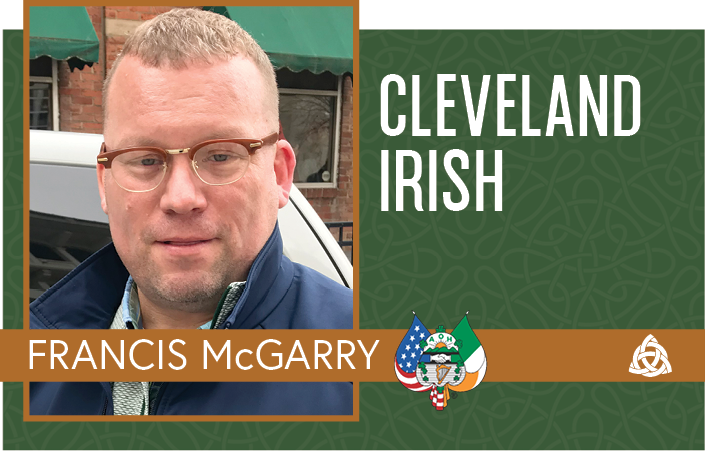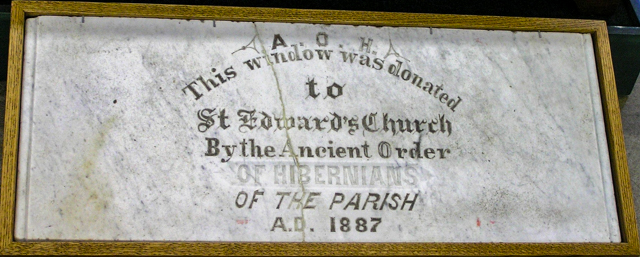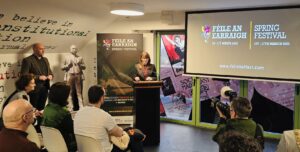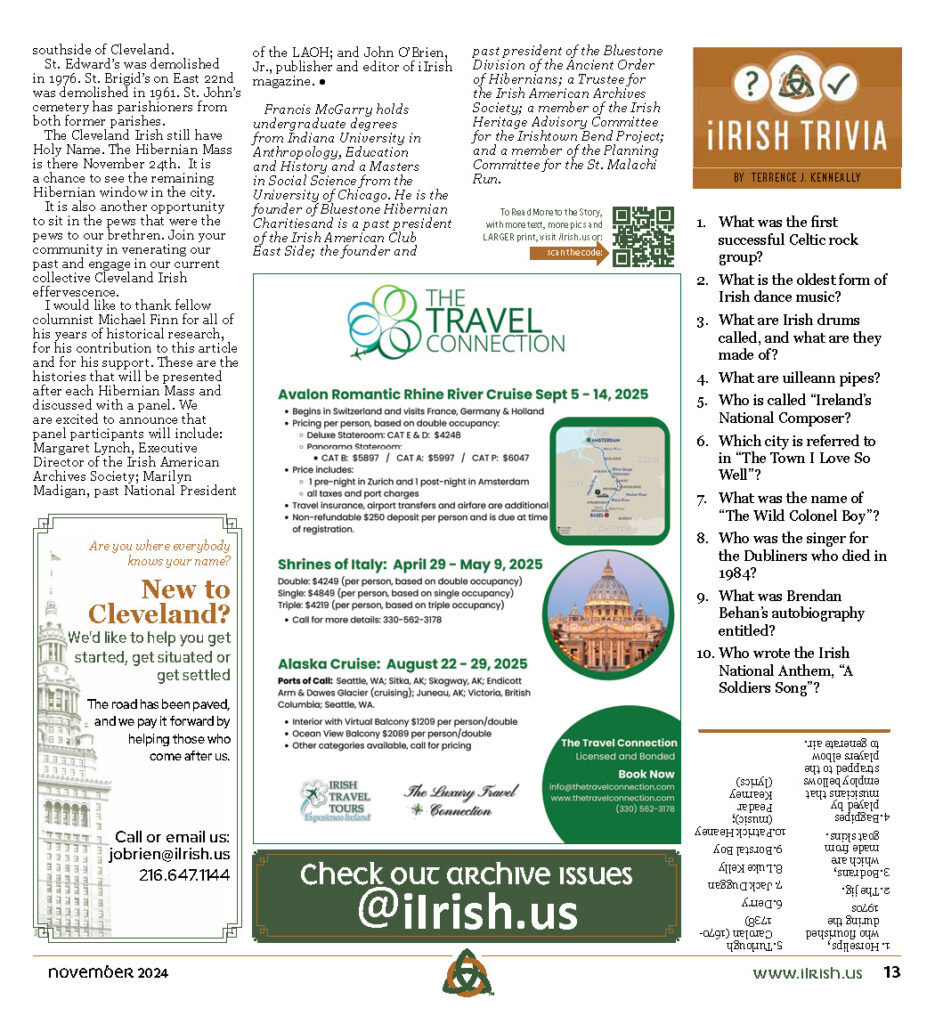
By Francis McGarry
Inter amicos omnium rerm communitas is the Latin for “Among friends all things are common.” Emile Durkheim was a French sociologist who studied societies and social facts. He coined the French term conscience collective, or collective consciousness. Durkheimian Theory contends societies are more than their collective parts and that communitas is an experience of zealous communal humanity that surpasses social structure.
Emile believed a community may gather from time to time and communicate a shared thought while participating in a collective action or event. This can result in increased intensity of individuals and the unification of the group, or community. This is called collective effervescence.
It is how we feel when we march down the Avenue on the feast of St. Patrick. It is also how one feels when you stroll through St. John Cemetery at 69th and Woodland.
There is something inspiring to see the rows of graves from the 1800s with Irish name after Irish name. St. John is next to the land that was the home of St. Edward’s Church and School.
Hibernian Windows
Last month, this article noted the Hibernian window at Holy Name Church [John will insert the link]. That window was donated by the Ladies Ancient Order of Hibernians (LAOH).
I noted two-thirds of the known Hibernian windows were donated by the LAOH. Michael Finn is the historian for the State of Ohio Ancient Order of Hibernians (AOH), and we have a shared communitas. He shared that the two-thirds was incorrect.
It was incorrect. 32 Hibernian windows were known to have been donated by the LAOH in 2008, as stated on the AOH website. This guy misread and misquoted that number. That number is now known to be 40 of the 346 Hibernian windows, as of February 2023.
That’s 338 in the United States, five in Canada and three in Ireland. Hibernian windows have been found in 35 states.
Ohio has 31 Hibernian windows. Massachusetts has 59, Pennsylvania has 42 and New York has 41. Cleveland had two windows.
One is at Holy Name. The other was at St. Edward’s and was donated by the AOH. It did not survive demolition.
We can thank JC Sullivan for rescuing the marble window sill that reads, “This window was donated to St. Edward’s Church by the Ancient Order of Hibernians of the parish, A.D. 1887.”
We can also thank JC for a life well lived in service to his country and his community. He passed away peacefully in September.
Those who knew him were better because of his humor and kindness. He will be missed in the Cleveland Irish community, the AOH and by all those who felt the collective effervescence upon his passing.
JC knew St. Edward’s Church and St. John Cemetery. As Bill Homan says, “See ya in Church, if they clean the windows.”
It was that second Hibernian window that elucidates the Cleveland Irish communities on the Southside. St. Edward’s parish was very Irish.
The first cornerstone was laid in April of 1885 with over 10,000 spectators present. Bishop Gilmour dedicated the church on February 1, 1886.
Father Matthew Scanlon was the first pastor. He was already well known among the Ohio Irish.

Fr. Scanlon
Father Scanlon moved to Cleveland in 1856 and completed his theological studies at St. Mary’s Seminary, which was on Lake Street at the time. He was ordained at the Cathedral and was assigned in 1859 to be the pastor of St. Vincent de Paul, the first Catholic parish in Akron.
In Akron, Father Scanlon built a new St. Vincent’s and the first cornerstone was laid on St. Patrick’s Day in 1864. The first Mass was celebrated after the Civil War in 1867.
He moved to St. Stephen’s Church in Niles. Father Scanlon built the school there.
It is not clear when he joined the AOH, but he was named State Delegate in 1876. Today we call the State Delegate the State President.
As State Delegate he passed a resolution critizing the Catholic press for its attacks on the AOH in connection with the Molly MaGuires in Pennsylvania. In 1877, ten Molly Maguires were hung in Pennsylania and ten more would be hanged before 1880. They were all Irish.
Historian Kevin Kenny’s Making Sense of the Molly Maguires discusses the intersections of labor, Irish immigration and resistance in Ireland and America. An Irish immigration that included the immigration of a collective consciousness.
Father Scanlon was transferred back to Cleveland in 1880. The Irish population on the southside of Cleveland necessitated the construction of a larger parish as new immigrants came to the city. It was Father Scanlon who oversaw the installation of the Hibernian window in 1887 at St. Edward’s Church.
12 years later, Father Scanlon passed away. His funeral was at St. Edward’s in 1899, and it was attended by over 100 clergy. Rev. O’Callaghan was the celebrant and Rev. O’Conner preached the sermon. Father Scanlon is buried in St. John’s Cemetery, one of the many Irish who rest there, waiting to be re-discovered.
Southside Irish
Chicago’s Southside Irish have a St. Patrick’s Day and Boston’s Parade is in Southie. There are few memories of the Irish on the southside of Cleveland.
St. Edward’s was demolished in 1976. St. Brigid’s on East 22nd was demolished in 1961. St. John’s cemetery has parishioners from both former parishes.
The Cleveland Irish still have Holy Name. The Hibernian Mass is there November 24th. It is a chance to see the remaining Hibernian window in the city.
It is also another opportunity to sit in the pews that were the pews to our brethren. Join your community in venerating our past and engage in our current collective Cleveland Irish effervescence.
I would like to thank fellow columnist Michael Finn for all of his years of historical research, for his contribution to this article and for his support. These are the histories that will be presented after each Hibernian Mass and discussed with a panel. We are excited to announce that panel participants will include: Margaret Lynch, Executive Director of the Irish American Archives Society; Marilyn Madigan, past National President of the LAOH; and John O’Brien, Jr., publisher and editor of iIrish magazine.
To read more of Francis’ Cleveland Irish Columns, Click HERE


‘Fleadh Cheoil would mark important milestone in Belfast’s ongoing transformation’
‘Fleadh Cheoil would mark important milestone in Belfast’s ongoing transformation’

This Just In: LAOH & AOH host Lost Gaels book events
This is happening, be in the know
This Just In: Sinn Féin leaders announce they will not attend White House events this year
This is happening, be in the know

Francis McGarry
*Francis McGarry holds undergraduate degrees from Indiana University in Anthropology, Education and History and a Masters in Social Science from the University of Chicago. He is the Executive Director of Bluestone Hibernian Charities and proprietor of McGarry Consulting. He is a past president of the Irish American Club East Side and the founder and past president of the Bluestone Division of the Ancient Order of Hibernians.






